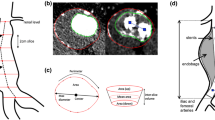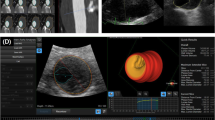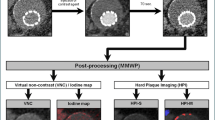Abstract
Purpose
Our aim was to assess the usefulness of volumetric analysis for the follow-up of abdominal aortic aneurysms after endovascular repair (EVAR) and operator independence of the method.
Materials and methods
We retrospectively evaluated 99 computed tomography (CT) exams of 33 patients. Two blinded operators assessed the volume before treatment and after EVAR at 1–3 and 12–24 months. Friedman’s statistical test was used to assess the reproducibility of the method. The time required for postprocessing by the two operators was compared.
Results
One patient was excluded. Twenty-one patients showed no endoleak: 12/21 showed a volume reduction at both follow-up scans (9.7% and 19.5%, respectively); 8/21 showed an early volume increase (9.8%) with a late reduction (10.5%); 1/21 patient showed a volume increase at both follow-up scans (endotension). Eleven patients had an endoleak (one type I, nine type II and one type III); 4/9 type II endoleaks showed a volume reduction at both post-EVAR scans (8.5% and 19.5%). All other cases showed a volume increase after EVAR (type II 15.4%/16.8%, type I 24.1%/9.1%, type III 8%/10.7%). The Friedman statistical test assessed operator independence with p < 0.001. Mean difference between the two operators was 0.9% (0–4.3%).
Conclusions
CT volume analysis is an accurate and reproducible modality for the follow-up of abdominal aortic aneurysms after EVAR. At early follow-up, contrast-enhanced CT remains mandatory to identify small endoleaks. For later follow-up, volumetric analysis would eliminate the need for contrast material in asymptomatic patients with stable or decreasing aneurysm volume.
Riassunto
Obiettivo
Scopo del presente lavoro è stato valutare l’utilità clinica dell’analisi volumetrica nel follow-up dei pazienti sottoposti a trattamento endovascolare per aneurisma dell’aorta addominale (EVAR) e stabilire l’indipendenza dall’operatore del metodo.
Materiali e metodi
Sono state valutate retrospettivamente 99 tomografie computererizzate (TC) di 33 pazienti. Due operatori in cieco hanno calcolato il volume prima e dopo EVAR a 1–3 e 12–24 mesi. È stato utilizzato il test statistico di Friedman per provare la riproducibilità del metodo. È stato inoltre confrontato il tempo necessario ai due operatori per il post-processing.
Risultati
Un paziente è stato escluso. In 21 pazienti non è stata osservata la presenza di endoleak: 12/21 presentavano una riduzione del volume ad entrambi i controlli (9,7%/19,5% rispettivamente); 8/21 presentavano un incremento iniziale (9,8%) con una riduzione tardiva (10,5%); in 1/21 il volume era incrementato ad entrambi i controlli (endotension). È stato osservato un endoleak in 11 pazienti (1/11 tipo I, 9/11 tipo II e 1/11 tipo III); 4/9 endoleak tipo II presentavano una riduzione volumetrica ad entrambi i controlli dopo EVAR (8,5%/19,5%). In tutti gli altri casi si è osservato un incremento volumetrico post-EVAR (tipo II 15,4%/16,8%, tipo I 24,1%/9,1%, tipo III 8%/10,7%). Il test statistico di Friedman ha dimostrato l’indipendenza dall’operatore con p<0,001. Lo scarto medio tra i due operatori è stato di 0,9% (0%–4,3%).
Conclusioni
Il calcolo del volume alla TC è un metodo accurato e riproducibile per il follow-up degli aneurismi dell’aorta addominale dopo EVAR. Al controllo precoce, l’impiego del mezzo di contrasto (MdC) rimane indispensabile per identificare la presenza di piccoli endoleak. Per i controlli successivi, l’analisi volumetrica consente di eliminare l’uso del MdC nei pazienti asintomatici con volume dell’aneurisma stabile o ridotto.
Similar content being viewed by others
References/Bibliografia
Brewster DC, Jones JE, Chung TK et al (2006) Long-term outcomes after endovascular abdominal aortic aneurysm repair: the first decade. Ann Surg 244:426–438
Baril DT, Silverberg D, Ellozy SH et al (2008) Endovascular stent-graft repair of failed endovascular abdominal aortic aneurysm repair. Ann Vasc Surg 22:30–36
Qu L, Hetzel G, Raithel D (2007) Seven years’ single center experience of Powerlink unibody bifurcated endograft for endovascular aortic aneurysm repair. J Cardiovasc Surg (Torino) 48:13–19
White GH, Yu W, May J et al (1997) Endoleak as a complication of endoluminal grafting of abdominal aortic aneurysms: classification, incidence, diagnosis, and management. J Endovasc Surg 4:152–168
Torsello G, Osada N, Florek HJ et al (2006) Longterm outcome after Talent endograft implantation for aneurysms of the abdominal aorta: a multicenter retrospective study. J Vasc Surg 43:277–284
Rozenblit AM, Patlas M, Rosenbaum AT et al (2003) Detection of endoleaks after endovascular repair of abdominal aortic aneurysm: value of unenhanced and delayed acquisitions. Radiology 227:426–433
Corriere MA, Feurer ID, Becker SY et al (2004) Endoleak following endovascular abdominal aortic aneurysm repair: implications for duration of screening. Ann Surg 239:800–805
Kranokpiraksa P, Kaufman JA (2008) Follow-up of endovascular aneurysm repair: plain radiography, ultrasound, CT/CT angiography, MR imaging/MR angiography, or what? J Vasc Interv Radiol 19:S27–S36
Chernyak V, Rozenblit AM, Patlas M et al (2006) Type II endoleak after endoaortic graft implantation: diagnosis with helical CT arteriography. Radiology 240:885–893
Sternbergh WC 3rd, Greenberg RK, Chuter TA, Tonnessen BH (2008) Redefining postoperative surveillance after endovascular aneurysm repair: recommendations based on 5-year follow-up in the US Zenith multicenter trial. J Vasc Surg 48:278–284
Hiramoto JS, Reilly LM, Schneider DB, Sivamurthy N et al (2007) Longterm outcome and reintervention after endovascular abdominal aortic aneurysm repair using the Zenith stent graft. J Vasc Surg 45:461–466
Tomlinson J, McNamara J, Matloubieh J et al (2007) Intermediate follow-up after endovascular aneurysm repair: can we forgo CT scanning in certain patients? Ann Vasc Surg 21:663–670
Macari M, Chandarana H, Schmidt B et al (2006) Abdominal aortic aneurysm: can the arterial phase at CT evaluation after endovascular repair be eliminated to reduce radiation dose? Radiology 241:908–914
Lee JT, Aziz IN, Lee JT et al (2003) Volume regression of abdominal aortic aneurysms and its relation to successful endoluminal exclusion. J Vasc Surg 38:1254–1263
Prinssen M, Verhoeven EL, Verhagen HJ, Blankensteijn JD (2003) Decisionmaking in follow-up after endovascular aneurysm repair based on diameter and volume measurements: a blinded comparison. Eur J Vasc Endovasc Surg 26:184–187
Buth J, Harris PL, Marrewijk CV (2002) Causes and outcomes of open conversion of aneurysm rupture after endovascular repair: can type II endoleaks be dangerous? J Am Coll Surg 194:S98–S102
van Marrewijk C, Buth J, Harris PL et al (2002) Significance of endoleaks after endovascular repair of abdominal aortic aneurysms: the EUROSTAR experience. J Vasc Surg 35:461–473
Jacobowitz GR, Rosen RJ, Riles TS (1999) The significance and management of the leaking endograft. Semin Vasc Surg 12:199–206
Tuerff SN, Rockman CB, Lamparello PJ et al (2002) Are type II (branch vessel) endoleaks really benign? Ann Vasc Surg 16:50–54
Czermak BV, Fraedrich G, Schocke MF et al (2001) Serial CT volume measurements after endovascular aortic aneurysm repair. J Endovasc Ther 8:380–389
Wever JJ, Blankensteijn JD, van Rijn JC et al (2000) Inter- and intraobserver variability of CT measurements obtained after endovascular repair. AJR Am J Roentgenol 175:1279–1282
Bargellini I, Cioni R, Petruzzi P et al (2005) Endovascular repair of abdominal aortic aneurysms: analysis of aneurysm volumetric changes at mid-term follow-up. Cardiovasc Intervent Radiol 28:426–433
Bley TA, Chase PJ, Reeder SB et al (2009) Endovascular abdominal aortic aneurysm repair: nonenhanced volumetric CT for follow-up. Radiology 253:253–262
Caldwell DP, Pulfer KA, Jaggi GR et al (2005) Aortic aneurysm volume calculation: effect of operator experience. Abdom Imaging 30:259–262
Brenner DJ, Elliston CD (2004) Estimated radiation risks potentially associated with full-body CT screening. Radiology 232:735–738
Brenner DJ and Hall EJ (2007) Computed tomography-an increasing source of radiation exposure. N Engl J Med 357:2277–2284
Alsac JM, Zarins CK, Heikkinen MA et al (2005) The impact of aortic endografts on renal function. J Vasc Surg 41:926–930
Waasdorp E, van’t Hullenaar C, van Herwaarden J et al (2007) Renal function after endovascular aortic aneurysm repair: a single-center experience with transrenal versus infrarenal fixation. J Endovasc Ther 14:130–137
Author information
Authors and Affiliations
Corresponding author
Rights and permissions
About this article
Cite this article
Canì, A., Cotta, E., Recaldini, C. et al. Volumetric analysis of the aneurysmal sac with computed tomography in the follow-up of abdominal aortic aneurysms after endovascular treatment. Radiol med 117, 72–84 (2012). https://doi.org/10.1007/s11547-011-0687-4
Received:
Accepted:
Published:
Issue Date:
DOI: https://doi.org/10.1007/s11547-011-0687-4




